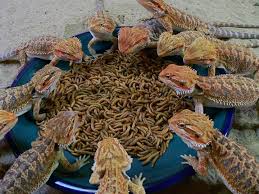What is a bearded dragon?
Pogona is the scientific name for what we know as the common name bearded dragons. The term “Bearded Dragon” refers to the “beard” of the dragon, the underside of the throat. The beard can turn black and puff out for several reasons, most often due to stress, or if they feel threatened.
The bearded dragon lives up to its name: Like a dragon, it’s equipped with the armour of spiny reptilian scales and looks as if it could blow out fire in any moment! The colour of them is tan to yellow and. If you run your finger down them, you will be able to experience the scales.
Bearded Dragons should measure anywhere from 16 to 24 inches in length and weigh 380 to 510 grams. Most of their size comes from their tail. Their tail is at least the same length as their body – if not longer.
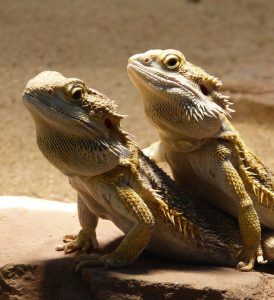
History of bearded dragons
Bearded dragons originated in inland Australia. The bearded dragon (also known as Pogona vitticeps) is one of the three hundred agamid lizard species.
You can find bearded dragons in dry, rocky, semi-desert regions and the parched open woodlands. They are out during the day (diurnal), but often spend the hottest part of the day in underground caves and adapted to cool desert nights.
Bearded Dragons did not commonly appear in the United States until the 1990s, but their popularity has grown since then.
Australia made it illegal to export any wildlife in the 1960’s. Scientists believe that bearded dragons, found outside Australia, were smuggled out of the country from the 1970’s to the early 1990’s. The general population of bearded dragons in the United States is so large that it is unnecessary to import any more since they can quickly reproduce.

Extra Interesting Fact:
One behavioural trait is their arm-waving. Hatchling and baby beardies will sometimes sit and wave their arm. The reason they wave is to introduce themselves as non-threatening to other dragons. It can appear as if they are waving “Hello” to you.
Buying a Bearded Dragon
The bearded dragons themselves are inexpensive to purchase, whether you buy them from a shelter or a shop. They usually cost about £20, whichever source you choose but bear in mind that there are many bearded dragons without a home in shelters.
Adoption
Blue cross, pets4home and many other charities offer you to adopt bearded dragons that need a new home.
Blue Cross says: “We help find the perfect pet for you by matching the pet to suit you and your family’s lifestyle, ensuring that whatever animal you adopt it is the right one for you.”
Private seller
On the other hand, websites such as gumtree allow people to post private listings of their bearded dragon. However, make sure you look carefully as sometimes the owners are not looking out for what is best for the bearded dragon.
Big shops
If you are looking for something with more guarantee. Pets at home sell bearded dragon. They can also provide you with more information. You can also pick up everything you need for your bearded dragon (cage, bedding, food) when you are there.
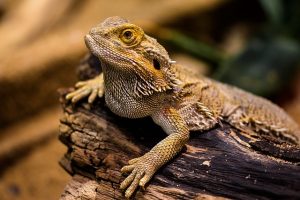
Are bearded dragons the right pet?
Bearded dragons have a peaceful and calm temperament. Though they are sometimes passive, over time, they get more relaxed.
Many reptiles do not enjoy interaction from humans, but this is not the case for bearded dragons. Bearded dragons enjoy being handled, exploring your home (under the correct supervision) and even with the right leash, you can take it out for a walk.
Like all animals, bearded dragons may bite. However, if they bite it, they are threatened or scared (don’t be worried though the bite feels like a small nip).
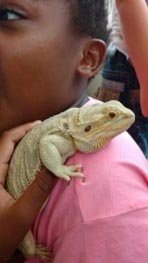
How caring are they?
Caring for a bearded dragon is simple, making them the right pet for both children and adults. The most time-consuming bit is setting up the enclosure with appropriate heat and lighting conditions (like an excellent UVB bulb)
Providing your bearded dragon with a proper diet and plenty of clean water is also vital yet inexpensive. These lizards enjoy various insects, fruits, and vegetables, so finding food they like is never a challenge.
Another plus to getting a bearded dragon is that they are intelligent animals. Bearded dragons have the intelligence to know who their owner is and develop a strong connection over time.
Bearded dragons also can be trained! You can teach them to come when called, get ready for food/water, and even walk on a leash.
How affectionate are they?
Unlike many reptiles, the bearded dragon can be an affectionate animal. The lizard likes to be warm, and it is not uncommon for them to snuggle into their owners’ necks or chests when they are taken out of their terrariums.
Start by talking or singing to your lizard when you come into the room. They will quickly get to know your voice and recognize that you are not a threat. Eventually, they’ll begin to associate you with positive things like food and playtime!
Finally, bearded dragons are fun to observe. They may run back and forth throughout their enclosure. Similarly, if its meal time they will be sure to let you know. Bearded dragons enjoy playtime. You can put a couple of toys into its enclosure or allow it to play with toys when it’s outside the terrarium. Some bearded dragons enjoy nudging a ping pong ball around. Others may enjoy playing with a ball of crinkled wrapping paper or a mylar ball cat toy.
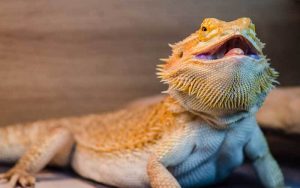
Housing your Bearded Dragon.
You will need an appropriately sized cabinet or aquarium. The basic size that is recommended is:
– Single bearded dragon need at least (900 x 350)cm / (35 x 14)”
– For a pair of bearded dragons (1 300 x 420)cm / (50 x 17)” is recommended
– The floor space should increase with at least 25 – 50% for every Bearded dragon added after that.
Ventilation is essential in the bearded dragon’s enclosure. Ventilation can be in the form of drilled holes or mesh. For inside enclosures, it is preferable to have ventilation on at least two sides of the enclosure.
Bearded dragon housing should be safe regarding sharp objects, escape routes, high climbing areas, and should offer protection from potential predators. Outside enclosures should be enclosed completely, even on the top.
When inside enclosures are used, lighting and heating accessories, and their wiring, needs to be installed. When aquariums are used, these are very often installed in the lid of the container. Wooden cabinets make it easy to install lighting and heating in better positions. Inside the enclosures, the ultraviolet lighting should be mounted within 30cm / 12″ above the main basking area.
A couple of Bearded dragons can be housed in the same enclosure. One adult male can easily be housed with a harem of females without problems. When two or more male dragons are housed together, the enclosure size should be significantly increased in an attempt to prevent territorial behaviour.
Clutches of baby Bearded dragons can be housed together in the same sized enclosure required to house one or two adult Bearded dragons in. When the babies reach five to six weeks of age, group sizes need to be reduced to about ten per enclosure. Groups should consist of more or less similar sized individuals.
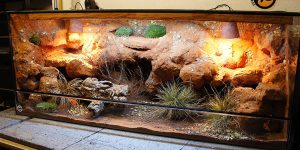
Bearded Dragon Diet
You need to replicate bearded dragon’s wild behaviours and eating habits. The correct diet for a bearded dragon should contain protein, greens, vegetables and fruits. Feeding a balanced diet is vital for their health. Feed a split of 25% insects and vertebrates and 75% greens, vegetables, and fruits. This will not only help keep them happy but also healthy too.
Adults should be fed once a day. Before serving any vegetables or fruits chop them into small bite-sized pieces – this will make them easier to eat.
If your bearded dragon does not eat their food you should remove it from their enclosure within an hour. This will prevent them from eating spoiled food and falling ill. Adults are typically good eaters. If they start to refuse food or eat less than normal speak with your vet as this could be the first sign of an illness or injury.
The following list of insects, vegetables and fruits are good choices to include in your bearded dragon’s diet:
– Dubia roaches, earthworms, crickets and superworms.
– Apples, blueberries, peaches, strawberries and watermelon.
– Cabbage, carrots, collard greens, kale, pumpkin and sweet potato.
Fruits are an important part of bearded dragon diets. They provide many vitamins, minerals, and other nutrients not readily found in other foods. The following fruits are good options to feed your bearded dragon:
– Apples
– Bananas
– Blueberries
– Grapes
– Strawberries
– Watermelon
You should only feed your bearded dragon fruits occasionally and use them as treats.

Disease
Bearded dragons have a few common health conditions. Some of them include metabolic bone disease, ‘mouth rot’, parasites, respiratory infections, and adenovirus infection.
However, when getting a bearded dragon, don’t expect them to be ill. If you look after them well, bearded dragons are reasonably hardy animals with a good diet and proper environment.
How can you tell if your bearded dragon is sick? Signs in a bearded dragon may be jaw or hind limb swelling. Any change from ordinary is a cause for concern you should evaluate by your veterinarian.
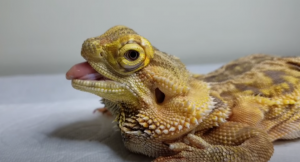
Grooming
If you clean your bearded dragon’s tank regularly, there is a little chance that your bearded dragon will be soiled or dirty. Bathing your bearded dragon from time to time can be an enjoyable experience.
Bating a bearded dragon is non-compulsory, if they do not enjoy it, do not wash them. But still, your bearded dragon might be dirty from bathing in a water dish with their faeces.
Bathing your bearded dragon will help wash off the faeces.
To bathe your bearded dragon, fill a plastic tub or sink with warm water (up to 2 inches or top of the limbs). Ensure that the water level is not higher than bearded dragon’s limbs, or it can drown.
Don’t add any soap or other chemicals into the water. Only use a soft brush or cloth to rub a dragon. You can also use your hands to hold your bearded dragon and rub it slightly.
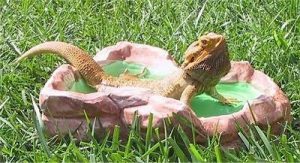
Lifespan
Before buying a bearded dragon, you need to consider how long you will have them as a pet for. The bearded dragon’s often live for around 10 – 15 years. Therefore, if you are looking to have your bearded dragon for not so long, we recommend adopting a mature bearded dragon.
Males usually live longer than females as they are larger. Bigger bearded dragons are more durable and can withstand harsher environmental
conditions.
However, just like humans, the lifespan is dependent on the quality of their life. You can significantly increase the chance of your bearded dragon living for a long time by doing the right things. For example:
- Diet
- Enclosure
- Temperature and humidity conditions
Also, it’s not only the things you do when you have the bearded dragon but research before helps! As we mentioned before, a giant bearded dragon means they will last longer, checking breeders’ history.
When you buy a beardie from a responsible breeder or seller, they are more likely to have healthy genes. That’s because the lizards are bred or sourced from breeders that do things the right way. Responsible sellers will also do their best to ensure your beardie is in good health when they sell them to you.

Excercise
You can take your bearded dragon for a walk, as we mentioned before, by purchasing a unique leash. The leash means they will get to experience the outdoors and feel some new surroundings.
However, if you do not have the specific leash, take your bearded dragon for a ride. When you are next visiting, the park takes them in a container. Always provide clean, dechlorinated water and a couple of snacks while out on your adventure, especially if it will be for several hours.
Take your bearded dragon for a swim. Fill up a large plastic storage bin at least twice as long as your bearded dragon makes for a perfect swimming hole. A small kiddie pool works well, too.
Ensure the water is no deeper than the bearded dragon’s elbows (or knees). Dechlorinate the water using ReptiSafe, or similar water conditioner, if using tap water. You can also use spring water, but avoid using distilled water.
Place a couple of small toys in the water for them to play with. A little rubber duck or similar toy would be perfect. On hot days place the swimming hole outdoors so he can play in the natural sunlight.
However, the best free exercise you can give your bearded dragon is handling it. When you first purchase your bearded dragon, you may need to gain its trust. After some time you can take your bearded dragon out nearly every day.
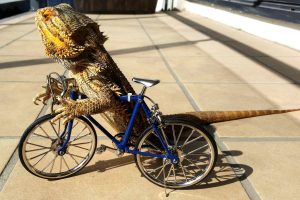
Breeds
When most people think about bearded dragons, they picture a sandy-coloured reptile. But many people may be surprised to discover that bearded dragons can come in a variety of different colours, patterns, and something referred to as morphs or mutations.
Hypomelanistic Morph: The term hypomelanistic means “below average “colour. In the case of this type of dragon, they look somewhat pastel in colouration. Hypomelanistic morphs are unable to produce dark patterns and colours.
Leatherback Morph: The main identifying trait of a leatherback bearded dragon morph is its smooth back.1 Leatherback morphs do not have spikes on their backs but have them on their heads and sides. The lack of points on their backs also makes their colours appear more vivid and makes them a popular bearded dragon morph.
Translucent Morph: As its name implies, the translucent bearded dragon morph is named due to its almost see-through spikes and scales. Baby translucent morphs have an almost clear belly that appears blue.
Silk back Morph – Possibly one of the unique types of bearded dragon morphs. They have smooth skin and vibrant colours since no scales are impeding them. Silk backs are also referred to as silkies because of how soft their skin feels.
German Giant Morph: Looks just like a standard or classic morph, the German giant morph is a huge bearded dragon. It is difficult to know whether or not you have a German giant until they are full-grown, and these morphs require a much larger enclosure because of their size.
Dunner Morph: Named after the breeder who created them, the Dunner morph looks similar to a classic morph except there is no obvious pattern to their scales.
Zero Morph: Extremely rare, the zero bearded dragon morph is completely lacking patterns and colours. These white-bearded dragons are growing in popularity.

Pregnancy
Before setting up a pair of bearded dragons for breeding, the habitat must be correct for the species.
The bearded dragons must be in optimum condition — especially the female — because breeding, developing eggs and then laying eggs (called oviposition) takes a lot of metabolic energy.
There should be enough room for two adult beardies to cohabitate comfortably, branches for climbing and a rock or nontoxic plant (or two) to allow one to retreat and hide from the other if necessary. Keep in mind that keeping your bearded dragons together is temporary. You will need two separate habitats in the long term and suitable habitat for the hatchlings when the time comes.
For optimum fertility, provide a period of decreased temperature and daylight hours, called brumation, for two to three months or a minimum of two to four weeks. Although many beardies successfully breed without a brumation period, you can expect decreased fertility if the rest period is not provided before breeding season.
Once a sexually mature male is ready to breed, its beard darkens. He will bob his head and stamp his front feet to gain the attention of a female. He may begin chasing her around the enclosure, and he may bite the base of the female’s neck while attempting to position himself for breeding. The male then everts a hemipenis and inserts it into the female’s cloaca.
